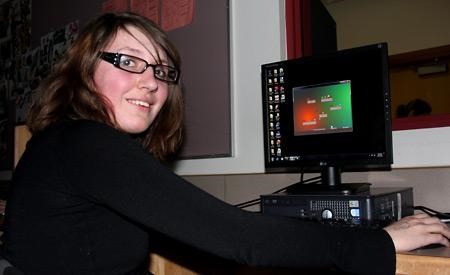It’s probably the only class at Brooks Secondary School where students are encouraged to put down their books and fire up some video games. Why is this allowed? Because the games are made by students.
Video Game Design and Development, a new course now in its second term, is offered to grade 11 and some grade 12 students. Students learn how to design and build their own video games, incorporating elements of computer technology, art, design and other skills. The first class was filled to capacity last term and this term is a similar story.
Along the walls and in two centre rows the glow of monitors illuminate students’ faces in the dimly lit classroom. Teacher Jerry Reghelin projects his computer screen onto the back wall, telling the students to turn off their monitors and pay attention from time to time as he explains something about “sprites” or “markers.” Students are pretty much left to their own devices aside from that and diligently plug away at whatever side-scroller or maze game they’re working on.
Reghelin said that students entering the course usually come in pretty excited, not realizing just how much work is going to be involved. Video game design is a different creature from video game playing and the math, physics and problem solving that comes into play while designing can make for a challenging endeavour. This challenge is also what gives the course its educational value. The students ended up driving the class in its first term, pushing Reghelin to move through the material faster.
“It’s probably the most positive classroom experience that I have,” said Reghelin. “That was a real switch around for me as a teacher, to have the students pulling me rather than me trying to pull them.”
Reghelin came up with the idea to start the class while at the 2008 National Educational Computing Conference, a professional development event in San Antonio, Texas. Reghelin attended a workshop on education theory and video game design. The workshop taught him the basics of the game-building software that the course uses, Game Maker Pro, and inspired him to start the gaming course at Brooks.
Aside from designing, students are also encouraged to discuss the cultural and personal impacts of video games and to consider what role gaming plays in society. Reghelin said they devote at least one class to discussing the social implications of video games and touch on issues such as the marginalization of women in games, online etiquette, video game violence, addiction and the sometimes blurred separation between reality and gaming fantasy.
“Video gaming is just another media and these kids are bombarded with these images and these ideas,” said Reghelin. “It’s really important to make them aware that this repetitive message that you’re getting isn’t necessarily the message you want to carry with you; to be a critical thinker of the stuff you’re getting.”
The demographics of gaming are changing as the industry develops. Reghelin, a gamer himself, said that the industry has come a long way from 10 years ago when gaming was considered to be solely the world of 14-year-old boys. Since then gaming has gone mainstream, helped especially by consoles such as Nintendo Wii, which has a wide market appeal, and brings in more revenue than movies.
Samantha Close, grade 11, is taking the course for the first time this term. Samantha is a gamer and decided to take the class because it sounded interesting and unique. She’s been impressed by how much work goes into a simple game and said that figuring out the physics inside a game is the hardest part.
Students who excel in the class will have greater opportunities for education and employment if they want to pursue a career in game design. The booming industry is looking for young talent and by getting a start in high school these students are one step ahead. Reghelin said the skills students learn in terms of problem solving and logic are essential life skills regardless of what they go into, but having programming experience can help them start out in a design career.
Aksel Huff, grade 11, is in his second term with the gaming course and has moved on from a shockingly complicated platform tank game, where the player must determine trajectories to destroy the opponent, to a three-dimensional first-person shooter. Aksel is taking his designing one step further by doing all of the program scripting himself, rather than using the software’s drag and drop game building tools. This means spending a lot of time outside the classroom working on his games and learning the finer details of coding. Aksel plans to continue studying programming after high school and hopes to work as a video game designer.
“I saw the course and knew I had to take it,” said Aksel. “I was interested in how things actually work. I want to be able to create my own worlds and to see that happen is awesome.”
Reghelin said that Aksel’s knowledge of scripting and of the software they use has surpassed his own, a common trend in the class that Reghelin loves to see.



